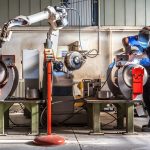Breaking products down for customization
Customers’ desire to take ownership of products is driving companies to develop more customized products. Élise Vareilles, a researcher in industrial engineering at IMT Mines Albi, works to develop interactive decision support tools. Her goal: help companies mass-produce customized goods while controlling the risks related to production. This research was presented at the IMT symposium on “Production Systems of the Future”.
This article is part of our series on “The future of production systems, between customization and sustainable development.”
Mr. Martin wants a red 5-door car with a sunroof. Mrs. Martin wants a hybrid with a rearview camera and leather seats. The salesperson wants to sell them a model combining all these features, but the “hybrid” and “sunroof” options are incompatible. More and more companies are beginning to offer customized services (loans, credit, etc.) and goods (cars, furniture, etc.). Yet they are facing a challenge: how can they mass-produce a product that will meet the customer’s specific request? To find a solution to this aspect, companies must customize their production. But how is this possible?
To configure their products, companies must, in a sense, cut them down into pieces. For example, for a car, they must separate the engine from the wheels and the bodywork. Identifying all these elements plays a major role in customizing a product.
“The goal is to develop computer tools that allow us to model each of these elements, like Lego bricks we put together. I have different color bricks, called “variants” and several shapes that represent options. We model their compatibility. Companies’ goal is to ensure the customer’s request can be met using all the options they offer,” explains Élise Vareilles, a researcher at IMT Mines Albi.
What catalog of products or services can I offer my customers using the options I have and their compatibility? To address this growing concern, Élise Vareilles’ team turned to artificial intelligence.
Identifying and controlling risks
The research team works on developing interactive configurators that enable a dialogue with the user. These configurators allow the user to enter various customization criteria for a product or service and view the result. For example, the options for your next car. To accomplish this, the artificial intelligence is fueled by the company’s knowledge. “We make computerized records of explicit knowledge (behavior laws, weight of components, etc.) and implicit knowledge related to the trade (manufacturing processes, best practices, etc.). All this information allows us to create modules, or building blocks, that make up the software’s knowledge base,” Élise Vareilles explains.
Yet not all a company’s knowledge is needed to manufacture each product. Therefore, the tool activates the relevant knowledge base according to the context specified by the user. Targeting this pertinent information allows the system to accompany the user by making suitable suggestions. Élise Vareilles adds, “with some configurators, I enter all my needs and they indicate, without explanation, that none of the products match my request. I do not know which options are causing this. Our tool guides the user by specifying the incompatibility of certain criteria. For example, it can tell the user that the size of the engine affects the size of the wheels and vice versa.”
Challenges 4.0 for the factory of the future
Researchers have developed a generic tool that can be applied to a variety of contexts. It has especially helped architects in configuring new insulation systems for the facades of 110 social housing units in the Landes area of France. “The best way to arrange the panels was to install them symmetrically, but the architects told us it didn’t look nice! An attractive appearance is not a parameter we can program with an equation. We had to find a compromise from among the software’s proposals by assessing all the assembly options and the constraints that only a human can evaluate,” the researcher recalls. The tool’s interactive aspect helped remedy this problem. It proposed assembly configurations for the insulation panels that the architects could adjust. It could also intervene to add to the architects’ proposals based on constraints related to the facades (windows, shutters, etc.) and the geometric nature of the panels.
In the context of the industry of the future, this type of tool could offer a competitive advantage by taking into account 80% of customers’ needs. It also helps control design costs. Breaking the knowledge and possible associations down into bricks means that the tool can help design increasingly adaptable products, which can be modified according to customers’ whims. It also increases the control of production risks by preventing the salesperson from selling a product that is too difficult or even impossible to manufacture. In addition, data mining techniques access the company’s memory to offer recommendations. However, if the knowledge is not constantly updated, the model faces the risk of becoming obsolete. The company’s experts must therefore determine the best time to update their tool.
Humans take on new roles
The two major risks involved in the manufacturing processes have therefore been reduced thanks to this tool from IMT Mines Albi. First, it reduces the risk of designing an object that does not match the customer’s request. By integrating knowledge from the company’s experts (risks, marketing, etc.) into the software, the company guarantees the feasibility of long projects. For example, the tool reduces risks linked to staff turnover, which could result in a loss of skills due to an engineer leaving the company.
However, humans are not being replaced. Instead, they are taking on new roles. “With this tool, 40% of an employee’s activities will be redirected to more complex tasks in which the added value of humans is undeniable. Keep in mind that our tool offers decision support and must rely on the previous work of experts,” Élise Vareilles adds. Yet implementing this type of solution is a long process—lasting approximately 2 years. This conflicts with the short-term investment mentality advocated by industrial culture. It’s now up to stakeholders to recognize these long-term benefits before their competition.
Article by Anaïs Culot, for I’MTech.





Leave a Reply
Want to join the discussion?Feel free to contribute!